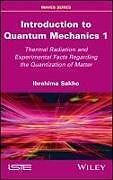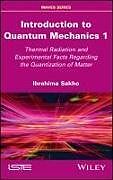Introduction to Quantum Mechanics 1
Einband:
Fester Einband
EAN:
9781786304872
Untertitel:
Thermal Radiation and Experimental Facts Regarding the Quantization of Matter
Genre:
Physik & Astronomie
Autor:
Ibrahima (University of Thies, Senegal) Sakho
Herausgeber:
ISTE Ltd and John Wiley & Sons Inc
Anzahl Seiten:
352
Erscheinungsdatum:
05.11.2019
ISBN:
978-1-78630-487-2
Autorentext
Ibrahima Sakho is a Doctor of Physical Science, and works at the science and technology training and research unit at the University of Thiès (Senegal). On-site, he teaches quantum mechanics, atomic and nuclear physics, radiation-matter interaction, and environmental chemistry.
Klappentext
The conception of lasers and optoelectronic devices such as solar cells have been made possible, thanks to the modern day mastery of processes that harness the interaction of electromagnetic radiation with matter. This first volume is dedicated to thermal radiation and experimental facts that reveal the quantification of matter. The study of black body radiation allows the introduction of fundamental precepts such as Planck�s law and the energy-related qualities that characterize radiation. The properties of light and wave-particle duality are also examined, based on the interpretation of light interferences, the photoelectric effect and the Compton effect. This book goes on to investigate the hydrogen atomic emission spectrum and how it dovetails into our understanding of quantum numbers to describe the energy, angular momentum, magnetic moment and spin of an electron. A look at the spectroscopic notation of the states explains the different wavelengths measured from the splitting of spectral lines. Finally, this first volume is completed by the study of de Broglie�s wave theory and Heisenberg�s uncertainty principle, which facilitated the advancement of quantum mechanics.
Inhalt
Foreword xi
Louis MARCHILDON Preface xiii Chapter 1. Thermal Radiation 1 1.1. Radiation 2 1.1.1. Definition 2 1.1.2. Origin of radiation 2 1.1.3. Classification of objects 4 1.2. Radiant flux 4 1.2.1. Definition of radiant flux, coefficient of absorption 4 1.2.2. Black body and gray body 5 1.3. Black body emission spectrum 6 1.3.1. Isotherms of a black body: experimental facts 6 1.3.2. Solid angle 7 1.3.3. Lambert's law, radiance 9 1.3.4. Kirchhoff's laws 10 1.3.5. Stefan-Boltzmann law, total energy exitance 11 1.3.6. Wien's laws, useful spectrum 12 1.3.7. The Rayleigh-Jeans law, "ultraviolet catastrophe" 15 1.3.8. Planck's law, monochromatic radiant exitance 16 1.4. Exercises 18 1.4.1. Exercise 1 - Calculation of the Stefan-Boltzmann constant 18 1.4.2. Exercise 2 - Calculation of the Sun's surface temperature 18 1.4.3. Exercise 3 - Average energy of a quantum oscillator, Planck's formula 19 1.4.4. Exercise 4 - Deduction of Wien's first law from Planck's formula 20 1.4.5. Exercise 5 - Total electromagnetic energy radiated by the black body 20 1.5. Solutions 21 1.5.1. Solution 1 - Calculation of the Stefan-Boltzmann constant 21 1.5.2. Solution 2 - Calculation of the Sun's surface temperature 23 1.5.3. Solution 3 - Average energy of a quantum oscillator, Planck's formula 24 1.5.4. Solution 4 - Deduction of Wien's law from Planck's law 27 1.5.5. Solution 5 - Total electromagnetic energy radiated by the black body 29 Chapter 2. Wave and Particle Aspects of Light 33 2.1. Light interferences 34 2.1.1. Elongation of a light wave 34 2.1.2. Total elongation of synchronous light sources 35 2.1.3. Young's experimental setup 36 2.1.4. Interference field, fringes of interference 37 2.1.5. Interpretation, interference as concept 37 2.1.6. Path difference 39 2.1.7. Fringe spacing, order of interference 41 2.2. Photoelectric effect 44 2.2.1. Experimental setup, definition 44 2.2.2. Interpretation, photon energy 44 2.2.3. Einstein relation, energy function 45 2.2.4. Photoelectric threshold 46 2.2.5. Stopping potential, saturation current 48 2.2.6. Quantum efficiency of a photoelectric cell 51 2.2.7. Sensitivity of a photoelectric cell 51 2.3. Compton effect 53 2.3.1. Experimental setup, definition 53 2.3.2. Energy and linear momentum of a relativistic particle 55 2.3.3. Interpretation, photon linear momentum, and Compton shift 56 2.4. Combining the particle- and wave-like aspects of light 59 2.4.1. Particle- and wave-like properties of the photon 59 2.4.2. Planck-Einstein relation 60 2.5. Exercises 61 2.5.1. Exercise 1 - Single-slit diffraction, interferences 61 2.5.2. Exercise 2 - Order of interference fringes 62 2.5.3. Exercise 3 - Experimental measurement of Planck constant and of the work function of an emissive photocathode 63 2.5.4. Exercise 4 - Experimental study of the behavior of a photoelectric cell, quantum efficiency and sensitivity 64 2.5.5. Exercise 5 - Compton backscattering 65 2.5.6. Exercise 6 - Energy and linear momentum of scattered photons and of the electron ejected by Compton effect 65 2.5.7. Exercise 7 - Inverse Compton effect 66 2.6. Solutions 66 2.6.1. Solution 1 - Single-slit diffraction, interferences 66 2.6.2. Solution 2 - Order of interference fringes 68 2.6.3. Solution 3 - Experimental measurement of Planck constant and of the work function of an emissive photocathode 70 2.6.4. Solution 4 - Experimental study of the behaviour of a photoelectric cell, quantum efficiency and sensitivity 74 2.6.5. Solution 5 - Compton backscattering 76 2.6.6. Solution 6 - Energy and linear momentum of the scattered photons and of the electron ejected by Compton effect 78 2.6.7. Solution 7 - Inverse Compton effect 79 Chapter 3. Quantum Numbers of the Electron 83 3.1. Experimental facts 85 3.1.1. Spectrometer 85 3.1.2. First lines of the hydrogen atom identified by Ångström 88 3.1.3. Balmer's formula 89 3.1.4. Rydberg constant for hydrogen 90 3.1.5. Ritz combination principle 92 3.2. Rutherford's planetary model of the atom 92 3.2.1. Rutherford's scattering, atomic nucleus 92 3.2.2. Limitations of the planetary model 94 3.3. Bohr's quantized model of the atom 95 3.3.1. Shell model of electron configurations 95 3.3.2. Bohr's postulates, principal quantum number 95 3.3.3. Absorption spectrum, emission spectrum 98 3.3.4. Principle of angular momentum quantization 99 3.3.5. Quantized expression of the energy of the hydrogen atom 100 3.3.6. Interpretation of spectral series 104 3.3.7. Energy diagram of the hydrogen atom, ionization energy 107 3.3.8. Advantages and limitations of Bohr's model 109 3.3.9. Reduced Rydberg constant 110 3.4. Sommerfeld's atomic model 111 3.4.1. Experimental facts: normal Zeeman effect 111 3.4.2. Bohr-Sommerfeld model, angular momentum quantum number 113 3.4.3. Atomic orbital, electron configuration 114 3.4.4. Interpretation of normal Zeeman effect, angular momentum quantum number 117 3.4.5. Advantages and limitations of the Bohr-Sommerfeld model 120 3.5. Electron spin 120 3.5.1. The Stern-Gerlach experiment 120 3.5.2. The Uhlenbeck and Goudsmit hypothesis, electron spin 121 3.5.3. Degree of degeneracy of energy levels 124 3.5.4. Total quantum number, selection rules 125 3.6. Electron magnetic moments 127 3.6.1. Orbital and spin magnetic moments 127 3.6.2. Magnetic potential energy 130 3.6.3. Spin-orbit interaction, spectroscopic notation of states 131 3.6.4. Fine structure of the levels of energy of the hydrogen atom 132 3.7. Exercises 135 3.7.1. Exercise 1 - Spectrum of hydrogen-like ions 136 3.7.2. Exercise 2 - Using the energy diagram of the lithium …

Leider konnten wir für diesen Artikel keine Preise ermitteln ...
billigbuch.ch sucht jetzt für Sie die besten Angebote ...
Die aktuellen Verkaufspreise von 6 Onlineshops werden in Realtime abgefragt.
Sie können das gewünschte Produkt anschliessend direkt beim Anbieter Ihrer Wahl bestellen.
Loading...
Die aktuellen Verkaufspreise von 6 Onlineshops werden in Realtime abgefragt.
Sie können das gewünschte Produkt anschliessend direkt beim Anbieter Ihrer Wahl bestellen.
| # | Onlineshop | Preis CHF | Versand CHF | Total CHF | ||
|---|---|---|---|---|---|---|
| 1 | Seller | 0.00 | 0.00 | 0.00 |
